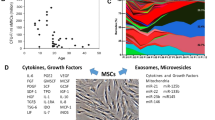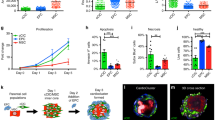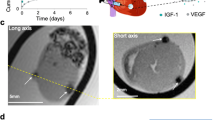Abstract
Despite promising preclinical data, the treatment of cardiovascular diseases using embryonic, bone-marrow-derived, and skeletal myoblast stem cells has not yet come to fruition within mainstream clinical practice. Major obstacles in cardiac stem cell investigations include the ability to monitor cell engraftment and survival following implantation within the myocardium. Several cellular imaging modalities, including reporter gene and MRI-based tracking approaches, have emerged that provide the means to identify, localize, and monitor stem cells longitudinally in vivo following implantation. This Review will examine the various cardiac cellular tracking modalities, including the combinatorial use of several probes in multimodality imaging, with a focus on data from the past 5 years.
Key Points
-
Two groups of contrast agents, superparamagnetic iron oxide nanoparticles (SPIOs) and to a lesser degree the gadolinium chelates, enable detection of cardiac stem cell populations by MRI following implantation
-
Currently, clinical application of in vivo tracking using SPIOs or gadolinium chelates in cardiovascular disease has several limitations
-
The ability to correlate cell viability with signals from radionuclide probes and reporter genes is a major advantage, although in vivo use of reporter genes is currently limited to animal models
-
Multimodality approaches combining both iron-based and radionuclide probes offer increased sensitivity and specificity for stem cell localization and tracking
-
Protocols using MRI and reporter genes to monitor stem cell transplantation are being developed and translation to the clinic will require nonimmunogenic probes that are stably expressed after implantation
This is a preview of subscription content, access via your institution
Access options
Subscribe to this journal
Receive 12 print issues and online access
$209.00 per year
only $17.42 per issue
Buy this article
- Purchase on Springer Link
- Instant access to full article PDF
Prices may be subject to local taxes which are calculated during checkout



Similar content being viewed by others
References
Wollert, K. C. et al. Intracoronary autologous bone-marrow cell transfer after myocardial infarction: the BOOST randomised controlled clinical trial. Lancet 364, 141–148 (2004).
Lunde, K. et al. Intracoronary injection of mononuclear bone marrow cells in acute myocardial infarction. N. Engl. J. Med. 355, 1199–1209 (2006).
Schachinger, V. et al. Intracoronary bone marrow-derived progenitor cells in acute myocardial infarction. N. Engl. J. Med. 355, 1210–1221 (2006).
Meyer, G. P. et al. Intracoronary bone marrow cell transfer after myocardial infarction: 5-year follow-up from the randomized-controlled BOOST trial. Eur. Heart J. doi: 10.1093/eurheartj/ehp374 (2009).
Sun, N., Lee, A. & Wu, J. C. Long term non-invasive imaging of embryonic stem cells using reporter genes. Nat. Protoc. 4, 1192–1201 (2009).
Pearl, J. & Wu, J. C. Seeing is believing: tracking cells to determine the effects of cell transplantation. Semin. Thorac. Cardiovasc. Surg. 20, 102–109 (2008).
Kim, R. J. et al. Relationship of MRI delayed contrast enhancement to irreversible injury, infarct age, and contractile function. Circulation 100, 1992–2002 (1999).
Gaztanaga, J. & Garcia, M. J. New noninvasive imaging technologies in coronary artery disease. Curr. Cardiol. Rep. 11, 252–257 (2009).
Kwong, R. Y. & Korlakunta, H. Diagnostic and prognostic value of cardiac magnetic resonance imaging in assessing myocardial viability. Top. Magn. Reson. Imaging 19, 15–24 (2008).
Lin, D. & Kramer, C. M. Late gadolinium-enhanced cardiac magnetic resonance. Curr. Cardiol. Rep. 10, 72–78 (2008).
Bulte, J. W. & Kraitchman, D. L. Iron oxide MR contrast agents for molecular and cellular imaging. NMR Biomed. 17, 484–499 (2004).
Arbab, A. S. et al. In vivo cellular imaging for translational medical research. Curr. Med. Imaging Rev. 5, 19–38 (2009).
Arbab, A. S., Liu, W. & Frank, J. A. Cellular magnetic resonance imaging: current status and future prospects. Expert Rev. Med. Devices 3, 427–439 (2006).
Modo, M., Hoehn, M. & Bulte, J. W. Cellular MR imaging. Mol. Imaging 4, 143–164 (2005).
Bulte, J. W. In vivo MRI cell tracking: clinical studies. Am. J. Roentgenol. 193, 314–325 (2009).
Frank, J. A. et al. Methods for magnetically labeling stem and other cells for detection by in vivo magnetic resonance imaging. Cytotherapy 6, 621–625 (2004).
Liu, W. & Frank, J. A. Detection and quantification of magnetically labeled cells by cellular MRI. Eur. J. Radiol. 70, 258–264 (2009).
Hare, J. M. & Chaparro, S. V. Cardiac regeneration and stem cell therapy. Curr. Opin. Organ. Transplant. 13, 536–542 (2008).
Stoll, G., Bendszus, M., Perez, J. & Pham, M. Magnetic resonance imaging of the peripheral nervous system. J. Neurol. 256, 1043–1051 (2009).
Jander, S., Schroeter, M. & Saleh, A. Imaging inflammation in acute brain ischemia. Stroke 38, 642–645 (2007).
Hill, J. M. et al. Serial cardiac magnetic resonance imaging of injected mesenchymal stem cells. Circulation 108, 1009–1014 (2003).
Kraitchman, D. L. et al. In vivo magnetic resonance imaging of mesenchymal stem cells in myocardial infarction. Circulation 107, 2290–2293 (2003).
Stuckey, D. J. et al. Iron particles for noninvasive monitoring of bone marrow stromal cell engraftment into, and isolation of viable engrafted donor cells from, the heart. Stem Cells 24, 1968–1975 (2006).
Terrovitis, J. et al. Magnetic resonance imaging overestimates ferumoxide-labeled stem cell survival after transplantation in the heart. Circulation 117, 1555–1562 (2008).
Dick, A. J. et al. Magnetic resonance fluoroscopy allows targeted delivery of mesenchymal stem cells to infarct borders in swine. Circulation 108, 2899–2904 (2003).
Wu, Y. L. et al. In situ labeling of immune cells with iron oxide particles: an approach to detect organ rejection by cellular MRI. Proc. Natl Acad. Sci. USA 103, 1852–1857 (2006).
Mani, V. et al. Serial in vivo positive contrast MRI of iron oxide-labeled embryonic stem cell-derived cardiac precursor cells in a mouse model of myocardial infarction. Magn. Reson. Med. 60, 73–81 (2008).
Himes, N. et al. In vivo MRI of embryonic stem cells in a mouse model of myocardial infarction. Magn. Reson. Med. 52, 1214–1219 (2004).
Kustermann, E. et al. Stem cell implantation in ischemic mouse heart: a high-resolution magnetic resonance imaging investigation. NMR Biomed. 18, 362–370 (2005).
Daldrup-Link, H. E. et al. Targeting of hematopoietic progenitor cells with MR contrast agents. Radiology 228, 760–767 (2003).
Daldrup-Link, H. E. et al. Migration of iron oxide-labeled human hematopoietic progenitor cells in a mouse model: in vivo monitoring with 1.5-T MR imaging equipment. Radiology 234, 197–205 (2005).
Amsalem, Y. et al. Iron-oxide labeling and outcome of transplanted mesenchymal stem cells in the infarcted myocardium. Circulation 116, I38–I45 (2007).
Kraitchman, D. L. et al. Dynamic imaging of allogeneic mesenchymal stem cells trafficking to myocardial infarction. Circulation 112, 1451–1461 (2005).
Leor, J. et al. Ex vivo activated human macrophages improve healing, remodeling, and function of the infarcted heart. Circulation 114, I94–I100 (2006).
Ebert, S. N. et al. Noninvasive tracking of cardiac embryonic stem cells in vivo using magnetic resonance imaging techniques. Stem Cells 25, 2936–2944 (2007).
Henning, T. D., Boddington, S. & Daldrup-Link, H. E. Labeling hESCs and hMSCs with iron oxide nanoparticles for non-invasive in vivo tracking with MR imaging. J. Vis. Exp. doi: 10.3791/685 (2008).
Amado, L. C. et al. Cardiac repair with intramyocardial injection of allogeneic mesenchymal stem cells after myocardial infarction. Proc. Natl Acad. Sci. USA 102, 11474–11479 (2005).
Carr, C. A. et al. Bone marrow-derived stromal cells home to and remain in the infarcted rat heart but fail to improve function: an in vivo cine-MRI study. Am. J. Physiol. Heart Circ. Physiol. 295, H533–H542 (2008).
Baklanov, D. V., Demuinck, E. D., Thompson, C. A. & Pearlman, J. D. Novel double contrast MRI technique for intramyocardial detection of percutaneously transplanted autologous cells. Magn. Reson. Med. 52, 1438–1442 (2004).
Rigol, M. et al. Hemosiderin deposits confounds tracking of iron-oxide-labeled stem cells: an experimental study. Transplant. Proc. 40, 3619–3622 (2008).
Qiao, H. et al. Embryonic stem cell grafting in normal and infarcted myocardium: serial assessment with MR imaging and PET dual detection. Radiology 250, 821–829 (2009).
Pawelczyk, E. et al. In vivo transfer of intracellular labels from locally implanted bone marrow stromal cells to resident tissue macrophages. PLoS One 4, e6712 (2009).
Pawelczyk, E. et al. In vitro model of bromodeoxyuridine or iron oxide nanoparticle uptake by activated macrophages from labeled stem cells: implications for cellular therapy. Stem Cells 26, 1366–1375 (2008).
Misselwitz, B., Platzek, J. & Weinmann, H. J. Early MR lymphography with gadofluorine M in rabbits. Radiology 231, 682–688 (2004).
Barkhausen, J., Ebert, W., Heyer, C., Debatin, J. F. & Weinmann, H. J. Detection of atherosclerotic plaque with gadofluorine-enhanced magnetic resonance imaging. Circulation 108, 605–609 (2003).
Nagel, E. et al. Magnetic resonance perfusion measurements for the noninvasive detection of coronary artery disease. Circulation 108, 432–437 (2003).
Rajagopalan, S. & Prince, M. Magnetic resonance angiographic techniques for the diagnosis of arterial disease. Cardiol. Clin. 20, 501–512 (2002).
Adler, E. et al. In vivo detection of embryonic stem cell-derived cardiovascular progenitor cells using Cy3-labeled gadofluorine M in murine myocadium. JACC Cardiovasc. Imaging 2, 1114–1122 (2009).
Modo, M., Beech, J. S., Meade, T. J., Williams, S. C. & Price, J. A chronic 1 year assessment of MRI contrast agent-labelled neural stem cell transplants in stroke. Neuroimage 47 (Suppl. 2), T133–T142 (2009).
Anderson, S. A., Lee, K. K. & Frank, J. A. Gadolinium-fullerenol as a paramagnetic contrast agent for cellular imaging. Invest. Radiol. 41, 332–338 (2006).
Hsiao, J. K. et al. Mesoporous silica nanoparticles as a delivery system of gadolinium for effective human stem cell tracking. Small 4, 1445–1452 (2008).
Zhang, Y. et al. Tracking stem cell therapy in the myocardium: applications of positron emission tomography. Curr. Pharm. Des. 14, 3835–3853 (2008).
Zhou, R., Acton, P. D. & Ferrari, V. A. Imaging stem cells implanted in infarcted myocardium. J. Am. Coll. Cardiol. 48, 2094–2106 (2006).
Thakur, M. L. et al. Indium-111-labeled cellular blood components: mechanism of labeling and intracellular location in human neutrophils. J. Nucl. Med. 18, 1022–1026 (1977).
Jin, Y. et al. Determining the minimum number of detectable cardiac-transplanted 111In-tropolone-labelled bone-marrow-derived mesenchymal stem cells by SPECT. Phys. Med. Biol. 50, 4445–4455 (2005).
Chin, B. B. et al. 111In oxine labelled mesenchymal stem cell SPECT after intravenous administration in myocardial infarction. Nucl. Med. Commun. 24, 1149–1154 (2003).
Brenner, W. et al. 111In-labeled CD34+ hematopoietic progenitor cells in a rat myocardial infarction model. J. Nucl. Med. 45, 512–518 (2004).
Lautamaki, R. & Bengel, F. M. Role of nuclear imaging in regenerative cardiology. Cardiol. Clin. 27, 355–367 (2009).
Hofmann, M. et al. Monitoring of bone marrow cell homing into the infarcted human myocardium. Circulation 111, 2198–2202 (2005).
Kang, W. J. et al. Tissue distribution of 18F-FDG-labeled peripheral hematopoietic stem cells after intracoronary administration in patients with myocardial infarction. J. Nucl. Med. 47, 1295–1301 (2006).
Doyle, B. et al. Dynamic tracking during intracoronary injection of 18F-FDG-labeled progenitor cell therapy for acute myocardial infarction. J. Nucl. Med. 48, 1708–1714 (2007).
Arbab, A. S. et al. In vivo cellular imaging for translational medical research. Curr. Med. Imaging Rev. 5, 19–38 (2009).
Cao, F. et al. In vivo visualization of embryonic stem cell survival, proliferation, and migration after cardiac delivery. Circulation 113, 1005–1014 (2006).
Wu, J. C. et al. Transcriptional profiling of reporter genes used for molecular imaging of embryonic stem cell transplantation. Physiol. Genomics 25, 29–38 (2006).
Willmann, J. K. et al. Imaging gene expression in human mesenchymal stem cells: from small to large animals. Radiology 252, 117–127 (2009).
Chen, I. Y. et al. Micro-positron emission tomography imaging of cardiac gene expression in rats using bicistronic adenoviral vector-mediated gene delivery. Circulation 109, 1415–1420 (2004).
Terrovitis, J. et al. Ectopic expression of the sodium-iodide symporter enables imaging of transplanted cardiac stem cells in vivo by single-photon emission computed tomography or positron emission tomography. J. Am. Coll. Cardiol. 52, 1652–1660 (2008).
Beeres, S. L. et al. Role of imaging in cardiac stem cell therapy. J. Am. Coll. Cardiol. 49, 1137–1148 (2007).
Seggewiss, R. et al. Acute myeloid leukemia is associated with retroviral gene transfer to hematopoietic progenitor cells in a rhesus macaque. Blood 107, 3865–3867 (2006).
Zhou, R. et al. In vivo detection of stem cells grafted in infarcted rat myocardium. J. Nucl. Med. 46, 816–822 (2005).
Blackwood, K. J. et al. In vivo SPECT quantification of transplanted cell survival after engraftment using (111)In-tropolone in infarcted canine myocardium. J. Nucl. Med. 50, 927–935 (2009).
de Vries, I. J. et al. Magnetic resonance tracking of dendritic cells in melanoma patients for monitoring of cellular therapy. Nat. Biotechnol. 23, 1407–1413 (2005).
Zhu, J., Zhou, L. & Xing-Wu, F. Tracking neural stem cells in patients with brain trauma. N. Engl. J. Med. 355, 2376–2378 (2006).
Toso, C. et al. Clinical magnetic resonance imaging of pancreatic islet grafts after iron nanoparticle labeling. Am. J. Transplant. 8, 701–706 (2008).
Neuwelt, E. A. et al. Ultrasmall superparamagnetic iron oxides (USPIOs): a future alternative magnetic resonance (MR) contrast agent for patients at risk for nephrogenic systemic fibrosis (NSF)? Kidney Int. 75, 465–474 (2009).
Acknowledgements
This work was supported in part by the intramural research program of the National Heart Lung and Blood Institute and the Clinical Center at the NIH.
Author information
Authors and Affiliations
Corresponding author
Ethics declarations
Competing interests
The authors declare no competing financial interests.
Rights and permissions
About this article
Cite this article
Lau, J., Anderson, S., Adler, E. et al. Imaging approaches for the study of cell-based cardiac therapies. Nat Rev Cardiol 7, 97–105 (2010). https://doi.org/10.1038/nrcardio.2009.227
Published:
Issue Date:
DOI: https://doi.org/10.1038/nrcardio.2009.227
This article is cited by
-
Cardiovascular Imaging Databases: Building Machine Learning Algorithms for Regenerative Medicine
Current Stem Cell Reports (2022)
-
Covalent assembly of nanoparticles as a peptidase-degradable platform for molecular MRI
Nature Communications (2017)
-
The potential utility of non-invasive imaging to monitor restoration of bladder structure and function following subtotal cystectomy (STC)
BMC Urology (2015)
-
Tracking of stem cells in vivo for cardiovascular applications
Journal of Cardiovascular Magnetic Resonance (2014)
-
Tissue kallikrein-modified human endothelial progenitor cell implantation improves cardiac function via enhanced activation of akt and increased angiogenesis
Laboratory Investigation (2013)



